|
As in making the Clyde a navigable river there were
many eminent names, connected with the works, brought forward from
time to time, so in the special and leading industries on its banks,
both in ship-building and engineering, there are many names which
have become household words, and will be honoured in the future as
in the past.
Henry Bell, whose monument stands beside the old fort
of Dunglass, overlooking the river which his enterprize has rendered
famous amongst the rivers of the world as the cradle of European
steam navigation, started his Comet in 1812. Bell was a clever,
enterprising man, and appears early to have turned his attention to
steamship propulsion, as in 1800 he tried some experiments in this
direction, and in the same year laid his plans before the Admiralty,
but without a successful issue. Lord Nelson, however, thought
differently, and with a deeper insight into the future than his
colleagues, said: , My Lords and gentlemen, if you do not adopt Mr.
Bell’s scheme other nations will, and in the end vex every vein of
this empire. It will succeed, and you should encourage Mr. Bell.”
The practical success was indeed very soon shown in America, where
Fulton, with a native-built boat and a Boulton .fc Watt engine,
started the Claremont on the Hudson, and it was not till about five
years later that Bell managed to get his long-cherished scheme
accomplished.
The Comet, begun in 1811, and launched in 1812, has
several well-known names associated with her, as she was built by
John Wood, of Port-Glasgow, “the father of all that is best in the
style of our ships, and truest in the practical application of
science in the ship-building trade of Great Britain.” David Napier,
afterwards so celebrated in connection with the development of the
steamship industry of the Clyde, made the boiler.
Bell’s Comet, after undergoing various changes, His wrecked off
Craignish, on the west coast, in October, 1820, and the engine was
afterwards recovered and finally placed in the Museum at South
Kensington, London. Bell was on board the Comet at the time of the
disaster, as lie had gone especially with the view of getting
subscribers for a bigger and more powerful boat. This was now gone
into vigorously, the West Highland lairds coming forward readily,
and in 1821 Comet No. 2 appeared, which, after plying for some time
to Inverness, was sunk by collision with the steamer Ayr, off
Gourock, on 20th October, 1S25; upwards of seventy people were lost
in this disaster. The vessel was afterwards raised and many valuable
articles recovered.
Henry Bell was born at Torphichen Mill, near
Linlithgow, on the 7th of April, 17G7; he died at Helensburgh on the
14th November, 1830, and was buried in the churchyard of Row, in the
neighbourhood.
That the early attempt by Bell had all the elements
of after success in it, appears from the following statement drawn
up by well-known early Clyde engineers:
“Glasgow, 2nd April, 1825.
“We, the undersigned engineers in Glasgow, having
been employed for some time past in making machines for steam
vessels on the Clyde, certify that the principles of the machinery
and paddles used by Henry Bell in his steamboat the Comet in 1812,
have undergone little or no alteration, notwithstanding several
attempts of ingenious persons to improve them.
Signed by Hugh and Robert Baird, John Neilson, David
and Robert Napier, David M‘Arthur, Claud Girdwood & Coy., Murdoch
& Cross, William M'Andrew, William Watson.”
Professor Rankine also remarks, in speaking of this
introduction of steam power: “Since that period the advancement of
steam navigation has consisted not so much in the development of new
principles, as in the improvement of workmanship, arrangement, and
economy of fuel, and the progressive increase of the size, power,
and speed of steamships, and the extent of their voyages.” The whole
subject of the introduction and development of steam propulsion is
one of great general interest, as illustrating the application of
mechanical skill and inventive genius in overcoming difficulties;
yet, in any general account of the progress from the early periods
until now (as the field is so wide and the interval of time great
since the first feeble attempts were made on inland rivers to use
the power of steam), we lose the more salient points in the
development because of the wide-spreading results with which we are
at the present day so familiar. For the last half-century we have
been living in an age of steam. In 1705, James Watt, while repairing
a model of a Newcomen engine belonging to the natural philosophy
class of the University of Glasgow, made his discovery of the
separate condenser. This afterwards, applied practically with many
other beautiful mechanical inventions, gave vigour to a machine
which formerly, from its elementary form and rude construction, had
been limited to the pumping of water. Although Watt made his
discovery in 17G5, it was not till the year 1781 that we find him
writing: “Our rotative engines, which we have now rendered very
complete, are certainly very applicable to the driving of cotton
mills, in every case where the convcniency of placing the mill in a
town, or ready-built manufactory, will compensate for the expense of
coals and of our premiums.”
As yet the steam-engine was on its trial, and
encountered great opposition ere it won its way by sheer force of
applicability to the many operations gradually opening up. In
reference to the great invention of James Watt, the late Professor
Macquorn Rankine says: “Watt set to work scientifically from the
first. Tie studied the laws of pressure of elastic fluids, and of
the evaporating action of heat, so far as they were known in his
time; he ascertained as accurately as he could, with the means of
experimenting at his disposal, the expenditure of fuel in
evaporating a given quantity of water, and the relations between the
temperature, pressure, and volume of steam. Then, reasoning from the
data which he had thus obtained, he framed a body of principles
expressing the conditions of the efficient and economic working of
the steam engine, which are embodied in an invention described by
himself in the following words, in the specification of his patent
of 1769: “‘My method of lessening the consumption of steam, and
consequently fuel, in fire engines, consists of the following
principles:
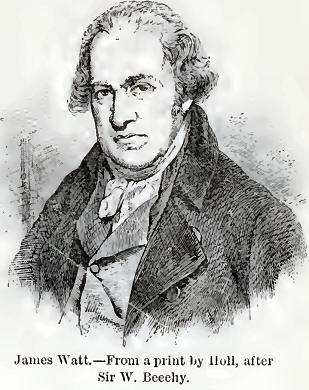
“‘Firstly, that vessel in which the powers of steam
are to be employed to work the engine, which is called the cylinder
in common fire-engines, and which I call the steam-vessel, must,
during the whole time the engine is at work, be kept as hot as the
steam that enters it; first, by inclosing it in a case of wood or
any other materials that transmit heat slowly; secondly, by
surrounding it with steam or other heated bodies; and thirdly, by
suffering neither water or any other substance colder than the steam
to enter or touch it during that time.
“‘Secondly, in engines that are to be worked wholly
or partially by condensation of steam, the steam is to be condensed
in vessels distinct from the steam-vessels or cylinders, although
occasionally communicating with them. These vessels T call
condensers; and whilst the engines are working, these condensers
ought at least to be kept as cold as the air in the neighbourhood of
the engines by application of water or other cold bodies.
“‘Thirdly, whatever air or other elastic vapour is
not condensed by the cold of the condenser, and may impede the
working of the engine, is to be drawn out of the steam-vessels or
condensers by means of pumps, wrought by the engines themselves or
otherwise.
"'Fourthly, I intend, in many cases, to employ the
expansive force of steam to press on the pistons, or whatever may be
used instead of them, in the same manner in which the pressure of
the atmosphere is now employed in common fire-engines. In cases
where cold water cannot be had in plenty the engines may be wrought
by this force of steam only, by discharging the steam into the air
after it has done its office.
Lastly, instead of using water to render the pistons
and other parts of the engines air and steam tight, I employ oils,
wax, resinous bodies, fat of animals, quicksilver, and other metals
in their fluid state.’ ”
The earlier forms of the Watt engine had wooden
“walking-beams.” An example of such an engine may be seen near the
Museum in the Kelviimrove Park of Glasgow, where it was re-erected
some years ago. Iron was afterwards substituted for the wooden beam,
and so designed as to give a maximum of strength, to resist the
heavy strains coming upon it, with a minimum of weight. The Blam-engine
still holds its place as a reliable engine for mill work, and the
Americans have retained it for their steamers at least on the
eastern waters and coasts. Watt’s prolific brain thought out from
time to time many important inventions which proved useful in the
development of the steam-engine.
In 1812 we start with the Come I, and by 1811 we have
in all seven steamers which had been built up to that year,
including the Industry, which, as the seventh steamer built on the
Clyde, is, as already stated, still in existence at the age of
seventy-four, lying rotting away in Bowling Harbour (see cut on p.
229). In 1820 we find the number of steamers as given in
the Steamboat Companion for that year plying on the Clyde to be
twenty-four, nine of which (including the first Comet) extended
their voyages to Fort-William, Campbeltown, Belfast, and Liverpool.
In 1828 the number, according to Dr. Cleland, extended to
fifty-nine, twenty-five of which were sea-going boats; Liverpool and
Dublin being, however, as yet the farthest ports ventured to. In
1836, another step of eight years, we find recorded in Fowler's
Commercial Directory for Renfrewshire seventy-eight
steamers as calling at Greenock, of which thirty-one were for
Liverpool, Dublin, Belfast, and generally ports beyond the end of
the firth. The voyages of the Sirius and Great Western to New York
in 1838 and the establishment of the Cunard Co. in 1840 brings us to
the period of ocean-going steamers, and the interest in the river
and coasting boats built or plyiug on the Clyde ceases to have a
paramount interest.
The engine of the Comet1 was of a somewhat peculiar
form, called a bell-crank arrangement, and, like a number of the
earlier engines, was connected to the paddle-wheels by spur gearing.
Afterwards the side-lever engine was commonly employed in sea-going
vessels, and the steeple and oscillating engine on river boats. The
custom in this country at least was to work the steam at low
pressure with the aid of the condenser. In some cases, however,
high-pressure steam was used; but its progress was checked by the
disastrous explosions which occurred, notably in the case of
the Telegraph at Helensburgh and the Cricket on the Thames. Broadly
speaking we had at first a period of wooden boats, bluft-bowed and
broad in proportion to length, driven more or loss by side-lever
engines, the propellers being paddle-wheels with fixed fioats. A
single long narrow funned rose abaft the paddle-box, and the vessels
were heavily sparred and rigged. Copper boilers in many cases were
used, and steam pressures of from 5 to 10 lbs. were common. The jet
condenser was in use, and the steam, when unused, was blown from a
steam-pipe led up alongside the funnel with a roaring noise. By a
simple arrangement it can now quietly escape into the water. The
regulating of the escape in the old boats was managed through a
safety-valve loaded with a series of discshaped weights, which could
be adjusted on the spindle of the safety-valve, placed upon the
steam-chest, immediately adjoining the funnel, and manipulated from
the deck by a stoker or attendant engineer.
The use of iron for shipbuilding did not become
general till about thirty-five years after the Comet was launched.
Some early attempts are recorded to have been made with canal boats
both in England and Scotland. John Wilkinson, of Lancaster, about
the year 1750 made an iron boat, and in 1787 another was tried on
one of the Staffordshire canals. In 1818 an iron boat named
the Vulcan (designed by Sir John Robinson, of Edinburgh, in 1816)
was built at Faskine, on the Monkland Canal, by Thomas Wilson. This
boat plied for a number of years on the Forth and Clyde Canal. Wood
has now almost disappeared as a building material for our vessels;
but on the Continent fully one-half of the vessels are still built
of that material.
The great drawback to the use of steam of a high
pressure in these times was the weakness of the boiler. Watt from
the first clearly saw the advantages in economy which would arise
from its use, but was unable, from the imperfect mechanical
appliances of his time, to obtain the necessary resisting strength
in the material employed.
In a few years after Bell’s Comet a goodly number of
steamers were plying on the Clyde, Built and cngined by different
constructors; some of these men ultimately rose to much distinction.
The name of Jas. Cook early appears as the engineer for several of
the early boats; thus the next steamer after the launch of the
first Comet was the Elizabeth, started on 9th of March, 1813. It was
engined by James Cook of Tradeston, as were a number of others later
on. David Napier is specially connected with the sea-going vessels,
as in 1818 the Bob Boy was cngined by him with a single side-lever
engine, a type much developed in later years. This vessel was built
by William Denny of Dumbarton, and thus we find a well-known name on
the Clyde appearing amongst the early builders of our sea-going
vessels. This same builder’s name, however, appears as early as
1814, when he built the river boats Trusty and Marjery. The Bob
Boy plied to Belfast, and was afterwards on the Dover and Calais
route. In 1817 Mr. Napier, like Mr. Seath at a later date, tried the
running of a steamer above the bridges.
The name of Robert Napier, however, is linked to
others who took a leading part in the development of ocean-going
steamers. We find the history of events bringing us in contact with
great commercial undertakings, and one more especially where the
Clyde and the Mersey in some measure joined hands. In 1824 the firm
of Messrs. G. & J. Burns was started, their vessels plying to the
North of Ireland. In 1828 they built their first steamer for the
Liverpool traffic. Mr. Napier became early associated with these
movements, and thus we find that in 1840, when the Cunard Co. was
established, and in the formation of which the Messrs. Burns and Mr.
Napier took a leading part, his engines were placed in the first
steamer of the company, and the steamers themselves were all built
on the Clyde by such well-known firms as those of Duncan, Wood, and
Steele.
In connection with this it is interesting to notice
that the four vessels with which the Cunard Coy. started in the
Liverpool and American service in 1840, viz. the Britannia, Acadia,
Caledonia, and Columbia, all wooden paddle boats of about 1100 tons
burthen each, have been year by year added to until the total number
of boats used since that time amounts to fifty-nine. After passing
through the period of iron, with paddle or screw, they are now built
of steel, with screw-propellers, such ships as
the Umbria and Etruria being of about 8000 tons burthen. The large
paddle ships culminated in the Scotia, also built for tho Cuuard Co.
by R. Napier & Sons in 1861. The dimensions of this boat were:
Lenoth, 366 feet; breadth, 47 feet 6 inches; tonnage, 4050. She had
two side-lever engines of a nominal horse-power of 1000. The
diameter of the cylinder was 100 inches; stroke, 12 feet. The
paddle-wheels were 40 feet diameter, and the size of the floats 11
feet 6 inches by 2 feet. Time of passage to New York, 9 days. This,
the last paddle steamer of the Cunard Co., was a very different
vessel from their first steamer the Britannia, no doubt considered a
wonderful boat in her day. The side-lever type of engine is
illustrated by the figure on p. 211, which shows the engine of
the Industry, and also the spur-wheel connection used in the older
boats.
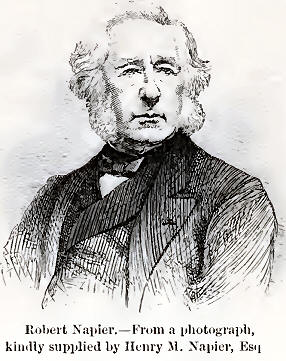
The first iron steam-vessel was the Aaron Manby, made
at “Horsely” in 1821, and put together at London. This vessel plied
on the Seine. The first iron steamer built on the Clyde was the Aglaia in
1827. This vessel plied on Loch Eck. The first iron steamer to ply
on the Clyde was the Fairy Queen, built in Glasgow at the Old Basin,
about a mile and a half from the river, to which she was carried,
and launched in 1831. This vessel plied to Largs about 1836.
The Vanguard was the first iron vessel built by R. Napier at Govaij
(1843). She plied for many years on the Glasgow and Dublin route.
The use. of wood, however, continued for many years,
all the early Atlantic steamers being built of this material; and it
was not till 1856, when the Persia was added to the celebrated
Cunard fleet, that that company introduced iron for the hulls of
their vessels. The firm of Tod & M‘Gregor is associated with the
first iron seagoing steamer, the Royal Sovereign, built in 1839. She
was engined by this firm and plied to Liverpool. The firm of T.
Wingate & Co. had the special honour of having made the engines of
the first steamer which crossed the Atlantic from Britain,
the Sirius, built in 1837 by Menzies & Sons, of Leith. The engines
were of the side-lever class, and had the special feature of being
fitted with Hall’s Surface Condenser. The name of Caird & Co., of
Greenock, is specially associated with the start of the deep-sea
boats belonging to the firm of Messrs. G. & J. Burns, as in 1828
they cngined the Glasgow for that company. The engines were
side-levers, the steam pressure being 5 lbs. per square inch.
TheLiverpool, a bigger ship than the Glasgoiv, was added to the same
company’s fleet in 1830, and was built by Steele & Co. of Greenock.
The Atrato for the West India Royal Mail Steam-Packet Co. was built
and engined by Caird Co., at Greenock, in 1854. Dimensions: 315 feet
long by 42 feet broad, and 26 feet 6 inches deep; gross tonnage,
3466; diameter of cylinder, 96 inches; stroke, 9 feet; nominal
horse-power, 800. The paddle-wheels had feathering floats. The
average ocean speed was 13'3 knots, with an average daily coal
consumpt of 100 tons. The Atrato was an iron vessel.
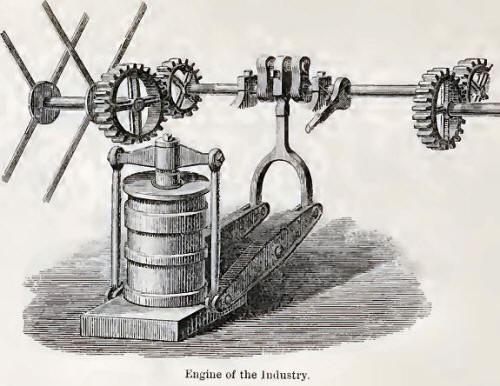
Experiments were being made from time to time with
the screw-propeller, early attempts being made with a screw or helix
of several turns. Stevens, at New York, tried a small vessel on the
Hudson in 1802. The cumne and propeller can still be seen at the
Stevens’ Institute, Hoboken. The engine is placed vertically, and
geared by a spur-wheel to the propeller shaft. Smith and Woodcroft
in this country, and Ericsson in America, also tried various
arrangements; and in 1840 the late Captain Kincaid of Greenock tried
a four-bladed propel lei In a steam-boat on the Forth and Clyde
Canal. But previously to that, and as early as 1828, Captain Kincaid
made a wooden four-bladed propeller, and experimented with it 011 a
long-boat in inid-occan. The actual propeller then used is now in
the Kelvingrove Museum. The first British steamer fitted with a
screw-propeller was the Archimedes, 237 tons, and built on the
Thames in 1839. This vessel appears to have come up to Glasgow on a
trip. The first screw-ship in H.M. navy was the Dwarf, an iron
vessel, built in 1843.
The Great Britain, built in 1843, was the largest
vessel of that day. It may be interesting to state some particulars
of this ship as noted at the time,1 as she was a departure in
several ways from what had gone before, both in size and method of
propulsion. In the journal referred to we find amongst other details
that “ the Great Britain is no doubt an object of great interest;
she differs from every other steamer which has ever crossed the
Atlantic; she is the largest—she is built of iron—and she is
propelled by the screw instead of paddles. She is thus destined to
test three principles:— The first as respects size. The advantage of
iron over wood as a material for marine architecture may already be
considered as established; but the trial of the Screw v. Paddle is
yet pending for want of sufficient evidence.” The Great
Britain still, or until recently, running, after nearly half a
century’s service, was designed by Brunei, and built at Bristol. She
was launched after some difficulty, on account of her unprecedented
size, in 1843. From an advertisement notifying her sale in 1881, the
dimensions are given as—length, 274-2 feet, or 322 feet over all;
breadth, 48‘2 feet; depth, 3T5 feet; 3270 gross tonnage. Engines by
J. Penn & Sons, Greenwich; and boilers by Fawcett, Preston & Co.,
Liverpool. Strongly built of Low Moor iron of the finest quality.
This vessel plied with much satisfaction in the Australian % trade.
The propeller was 16 feet diameter; the main shaft was hollow,
measuring 28 inches diameter outside and 10 inches inside: this part
being bored out and a stream of water sent through it to keep the
bearings cool. The engines were geared to the shaft. The Great
Britain, like the Great Eastern, made her first trips across to New
York, the passage being fifteen days. In one of her outward trips,
by a mistake as to the lights, she got ashore in Dundrum Bay on the
Irish coast, and lay there for a considerable time. This event,
occurring to this wonderful ship of the time, was reckoned
sufficiently notable to be illustrated in one of the views of a
panorama which came to Glasgow after the mishap; the describer
carefully pointing out to the spectators the position of the
“propeller,” which could be easily seen, as the vessel was shown at
low-water, pretty much high and dry.
Shortly after this, in 1845, the first iron
screw-steamer, the Fire Queen, was built at Glasgow; and in 1850,
the City of Glasgow, of 1001 tons, commenced to ply between Glasgow
and New York. This vessel was built by Tod & M'Gregor, and was an
iron screw-steamer of 1600 tons, measuring 227 feet long by 82 feet
7 inches broad, and 24 feet 7 inches deep. She had two geared beam-cngines
of 880 horse-power; the propeller was 14 feet diameter.
The City of Glasgow left Glasgow on the 16th of
April, 1850, and arrived in New York on the 8d of May, after a
passage of 16 days 21 hours. She encountered head winds ; her
greatest day’s run was 241 knots. The return voyage was made in 14
days 6 hours; greatest day’s run, 203 knots.
Attempts were made from time to time to increase the
effective action of the paddle-wheel, the feathering float being the
most important improvement. (See cut p. 21C.)
The Glasgow, which followed her, was the first
steamer belonging to the Inman Company, so long well-known on the
Atlantic route for its swift and commodious steamers. This company,
under the new designation of the Inman and International Company,
are at present having two very large Atlantic liners built and
engined on the Clyde by Messrs. J. & G. Thomson, Clydebank;
twin-screws of about 10,000 tons, with corresponding power and
equipment.
The Glasgow left Glasgow for New York on 16th
September, 1857, and arrived on the 30th of the same month; the
greatest day’s run was 254 knots. She left,New York on the 11th and
arrived in the Clyde on the 28th October; greatest day’s run, 262
knots.
The dimensions of the City of New York now launched
are: length on water-line, 525 feet; breadth, 63£ feet; depth,
moulded, 42 feet; tonnage, 10,500. This vessel is fitted with
twin-screws and triple expansion engines.
The Collins line, belonging to the United States,
started in 1850, and continued to run for about ten years; their
vessels were large paddle-wheel steamers.
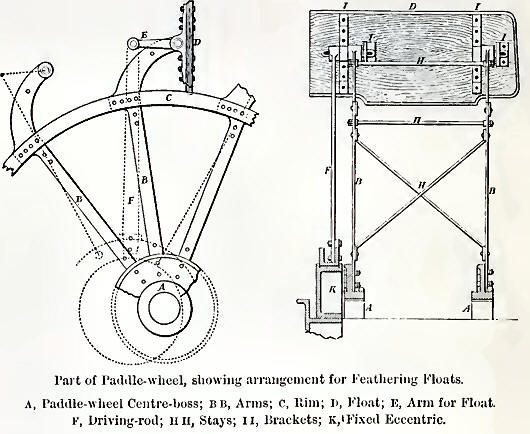
It is just about thirty years since the iron vessel
and screw-propeller may be said to have taken a prominent place in
the history of naval architecture. About the time of the
introduction of the screw-propeller for oceangoing vessels it was
thought hy some that a modified application might prove commercially
successful; and this gave rise to auxiliary screw-propellers, the
idea being to aid the force of the wind upon the sails by means of
steam-power applied to a screw-propeller. To test the correctness of
this, a vessel was built at Liverpool in 1846, called the Sarah
Sands, of 1100 tons, and made several voyages between that port and
New York, her passages occupying about seventeen days. This vessel
was nearly destroyed by fire in the Indian Ocean while conveying
troops during the Indian mutiny. For the following incidents the
author is indebted to one of the passengers:—The vessel sailed from
Portsmouth on 15th August, 1857, having on board 350 officers and
men of the 54th Regiment; on the 11th November lire broke out, and
raged so furiously that it was only through the military discipline
that it was got under; to add to the danger, during the
conflagration some powder exploded in the after-part of the ship.
The women and children were placed in boats and rafts which lay
alongside. The iron got white-hot, and the masts went overboard, but
finally the fire was extinguished and some sail got up. The boats
lying around were then taken in. They had been followed by shoals of
sharks, which had been attracted by the light and the prospect of
making the castaways their prey. The chronometer was lost, and the
watches of the officers were used instead. A course was set for the
nearest land, the Mauritius, 1000 miles distant, and the weather
fortunately remaining fine, the battered craft and miserable-looking
ship’s company arrived safely on the 23d November.
Another incident of the sea may be mentioned in
connection with the Three Bells, built at Dumbarton by Messrs. Win.
Denny Brothers in 1851. She was the largest iron sailing ship afloat
at the time, and during one of her voyages came upon the San
Francisco, a United States transport, which had a number of troops
on board. As this vessel was in a sinking condition the captain of
the Three Bellsdetermined to stand by them till morning, so that
help might be given, which incident has been described by the poet
Whittier in the following lines:
“Beneath the low-hung night cloud
That raked her splintering mast
Tlie good ship settled slowly,
The cruel leak gained fast.
“A voice came down the wild wind,
‘IIo! Ship ahoy! ’ its cry :
Our stout Three Bells of Glasgow
Shall lay till daylight by!’
“All night across the waters
The tossing lights shone clear;
All night from reeling tatl'rail
The Three Bells sent her cheer.
“And when the dreary watches
Of storm and darkness passed,
Just as the wreck lurched under,
All souls were saved at last.”
The firm of Randolph & Elder is inseparably
associated with the successful introduction of the compound engine,
as that of R. Napier & Sons is now with the triple-expansion system.
In a memoir of John Elder, by the late Professor Macquorn
Rankine, we find that Elder mastered the subject of reduction of
friction by neutralizing the forces which drive the shaft. In 1853
they patented vertical direct-acting and geared compound engines for
driving a screw-propeller; in 185G, two opposite cranks; in 1858,
three cranks. The first vessel fitted with a compound engine by
Randolph, Elder, & Co. was the Brandon in 1854, the consumpt of coal
obtained being 3^ lbs. per indicated horse-power per hour; formerly
this consumpt had been as high as 4 to 41, lbs.
After this the Pacific Steam Navigation Company got
two paddle steamers built—the Inca and Valparaiso. These were fitted
with Randolph & Elder’s compound engines in 1856, the consumpt being
from 2½ to 3 lbs., “a degree of economy never before realized in
marine engines; and this was not only obtained on the trial trips,
but maintained during many years’ subsequent service at sea. It
amounted to a saving of from 30 to 40 pel cent of the coal
previously burned by steamers of the same class.” This great
reduction of fuel now made long ocean passages commercially
practicable.
In the Memorials of James Watt, published in 1856, it
is stated that “at that time by far the largest proportion of
steam-vessels launched in the Clyde are of iron,” and “of the whole
steam-vessels constructed on the Clyde, or in progress at the
various building-yards in 1852, amounting in all to 73, only four
were of wood; while the proportion of screws to paddle-wheels was as
43 to 30.” TheTimes, treating of shipbuilding in 1883, says: “One
fact, emphasized by the returns for the year under review, is, that
wood has practically, if not absolutely, gone out of existence as a
shipbuilding material. Iron is now the general material of which
vessels are constructed, though steel is year by year coming to the
front. This is particularly shown in the returns from the Clyde.
Very few years have elapsed since the first steel ship was launched
on the Clyde. Four years ago the entire output of steel vessels was
18,000 tons. In 1882 the quantity had been increased to fully
100,000, and in 1883 it rose to 120,000 tons, or nearly one-third of
the whole tonnage launched, the proximity of steel-plate works, and
the distance of the source of part of the supply of iron plates
undoubtedly contributing to that change. In the north-east ports the
number of steel vessels built is much fewer. On the Tyne 12 vessels
have been built of steel, and on the Wear 4. But in the Scotch and
Irish ports this material is being increasingly used, and in
addition to the Clyde, Grangemouth and Belfast have used it largely.
Another fact prominently brought out is that sailing are speedily
giving way to steam-vessels. Of the 32G vessels launched on the
Clyde during the year, 240 are steam and only 8G sailing. On the
Tyne not one sailing vessel has been built, and on the Wear one
only. Taken all round, the size of the vessels has increased. The
Clyde still holds its own for vessels of the largest class; but
taking an average between large and small, the Tyne and Wear show
larger figures than the Clyde. Boughly stated, the average is as
follows:— Clyde-built vessels, 1210; Tyne, 1400; Wear, 1G85.”
The most of our great ocean liners of the present day
are built of steel. This material, both in ship plates, angles, &c.,
and in boiler plates, has within the last few years largely replaced
the use of wrought iron,—partly due to its greater strength, whereby
less material is required; a very great advantage, when we consider
the great weight of the vessels and boilers of the present day. The
use of steel for shipbuilding is not, however, altogether new, as,
about twenty-five years ago, some river steamers were built on the
Clyde of that material.
Mr. Robert Duncan, speaking on the classification of
shipping, gives the following statistics of the comparative.
The consumpt of coal in all the earlier sea-going
steamers was excessive, consequently the available space for
merchandise was very limited, giving rise to the belief expressed at
the time of the first ocean passages, that it would be impossible to
carry on a commercially successful traffic with steam. In reference
to this, Sir William Pearce, Bart., in a lecture delivered in
1881, points out that thePersia burned 6’3 tons of coal for every
ton of cargo she carried; whilst the Gallia, built in 1879, and
fitted with screw-propeller and compound engines, burned only about
half a ton of coal for every ton of cargo, and, besides, carried
this cargo about two and a half knots faster. Still further,
the Arizona, also built in 1879, burns only 5 cwts. of coal for
every ton of cargo carried. The daily coal consumpt in
the Persia was 150 tons per day, the indicated power 8600, or 3'7
lbs. of coal per indicated horse-power. In the Gallia the daily
consumpt was 97 tons, the indicated power 5000, or 1/8 lbs. per
indicated horse-power per hour. In the Arizona the daily consumpt
was about 110 tons or P75 lbs. per I.H.P. The speeds of
the Persia, Gallia, number of vessels built at ports in Great
Britain in 1886:—

In connection with the subject of the size of our
future sea-going steam-vessels, Mr. William Denny says (Watt
Lecture, 1882): “Steamers were increasing in size, and the least
costly increase for weight-carrying, and, up to certain points, for
speed, was in beam, provided sufficient draughts could be obtained.
Steamers would follow their natural course of development, and it
would be for dock proprietors, river trustees, and harbour boards to
see that their docks, rivers, and harbours were of such depth as to
permit them to favour steamers so developed. He believed it was
found daily more difficult to build the larger types of Atlantic
steamers rigid enough for the service, even with the great
percentage of their displacement devoted to structural weight. A
reaction would set in against their extreme proportions and absolute
length. When that happened, beam would be increased; as a
consequence draught increased, and distinct preferences accorded to
ports having great draught of water. Besides, great draught of
water, and comparative shortness of a steamer, were more favourable
to the efficiency of the screw, by keeping it well immersed, than
great length with shallow draught, which told very much against the
screw’s efficiency.” Mr. Denny further states that he he is “
convinced that the steamer which was to do the Atlantic work would
be a vessel of what might be called at the present time moderate
length. That was a vessel which would not only be shorter than
the City of Rome, but shorter than the Servia, and shorter than
the Alaska, which, of the three steamers, as far as he could learn,
came nearest the type he had in view. He believed the steamer to do
this work would he under 500 feet in length between perpendiculars.
What her other dimensions should be would have to be fixed by
experiment and a very careful series of calculations.”
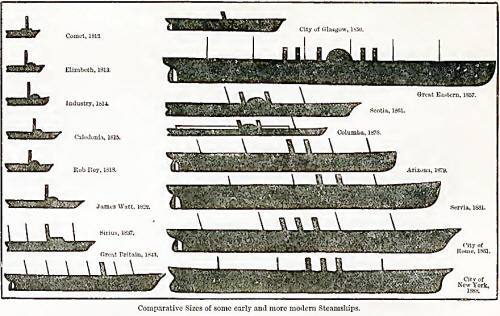
The annexed diagram of the comparative sizes of some
leading steam vessels was originally used to illustrate a lecture
delivered by the author during the Naval Exhibition, held in Glasgow
in 1880-81, under the auspices of the city authorities.
The compound engine, as introduced on the Clyde by
Randolph, Elder & Co., in the first mercantile steamer fitted with
this form of engine, the Ihxmdoii, in 1854, reduced the consumpt of
fuel to a large extent, later on, due to further improvements, such
as surface condensation, the use of three cylinders instead of two,
wherehy the efforts on the shaft were more completely equalized, the
consumpt was further reduced, until, in the latest compound engines,
less than 2 lbs. of coal were required. Recently the
triple-expansion engine has been introduced, whereby a further
saving in coal is obtained. In this form of engine the expansive
action of the steam is carried out through three cylinders
consecutively—that is, it is admitted from the boiler into the first
and smallest cylinder and, after driving the piston of that cylinder
before it for a part of the stroke, the admission of the steam is
cut off, the rest of the stroke being accomplished by the expansion
of the steam already admitted. Thereafter this steam passes into the
next or intermediate cylinder, and presses forward the piston in
that cylinder, and finally, as its expansive power is not yet
exhausted, it is allowed to enter the third cylinder, pressing
forward in turn the piston there. The-intensity of the pressure, as
it enters the second or intermediate cylinder, is much less than
when entering the first; hut as this cylinder is made
proportionately wider, and has therefore a greater area of piston,
the total driving power on the piston is still obtained about equal
to that in the first cylinder. The third cylinder is in turn larger
than the second cylinder. Certain proportions have been adopted as
best suited to equalize the pressures on the pistons, and from
thence to the cranks.
The quadruple-expansion engine, of which a few have
been made, is simply, like the triple-expansion engine, a
development of the compound—that is to say, in the compound the
steam was expanded through two cylinders, in the triple through
three, and in the quadruple through four, higher pressures being
required in the triple and quadruple forms than in the compound, as
the range of expansion is greater. Here, however, we touch the main
item in the increased economy of the later forms, and which may be
shortly referred to.
Generally speaking, steam when expanding may lie
represented as following what is known as Boyle’s law of gaseous
expansion—that is, that the pressure varies inversely as the volume;
so that if, in the triple-expansion engine above referred to, we
suppose that the steam is cut off from the boiler after driving the
piston through half of the stroke, or when one-half of the cylinder
is full, then at the end of the stroke the volume of steam will be
double of what it was when cut off. The pressure, therefore, will be
only one-half of what it was before being cut off—that is to say,
the volume having doubled, the pressure has fallen to one-half. In
like manner, when the volume has further increased—say to five
times—then the pressure will be reduced to one-fifth. It will now be
found that the mean pressure is higher when the expansion is
considerable, in proportion to the steam used. Thus, if the steam
were not used expansively at all the pressure would be uniform
throughout the stroke; but a whole cylinder full of steam would be
used. If cut off at say half-stroke, the mean pressure would now be
approximately seven-eighths of what it was in the first case. But
only one-half of the steam is now used.
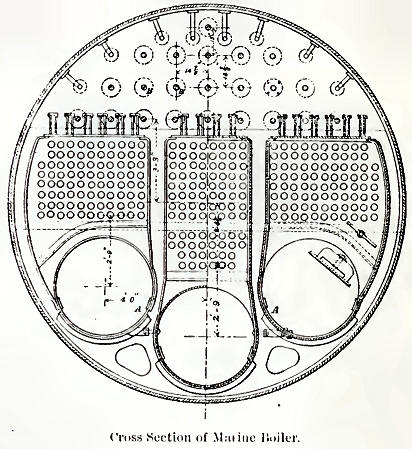
It is, therefore, economical to use the expansive
force of the steam; and to do this with the greatest effect a long
cylinder or a series of cylinders is necessary. It is also necessary
that the initial pressure be high, so as to take advantage of
expansion to the fullest.
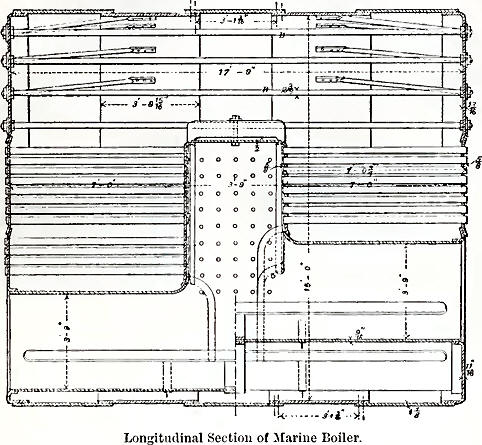
In the compound system, therefore, an advantage is
gained; and in the triple and quadruple systems a still further
improvement arises from the use of steam at a higher pressure and
expanded more fully, whereby less steam can be made to give a better
mean result. A saving is thus effected, both in coal consumed and in
boiler space. Pressures have now reached 160 lbs. and 170 lbs.
per square inch, and will, no doubt, go higher still. The limit of
economical working cannot, however, be far off, as with increased
pressure difficulties will be met from the greater heat of the steam
affecting the working parts.
The whole question of economical working, in a word,
depends upon the amount of effective work which can be obtained from
the coal consumed. So that, not only is the engine subject to
further improvement, but also the boiler and furnace. Combustion by
forced draught, &c., are all elements in the question. From the
combustion of 1 lb. of coal about 14,500 thermal units should be
obtained. Roughly speaking, this energy may be stated to be expended
as follows:—In the triple-expansion engines as now used at sea, we
may take 1 lb. of coal consumed per hour as equivalent to one
horse-power; but as one horse-power rcpresentl 33,000 foot-pounds of
work done per minute, then the total work done by the combustion of
the If lb. of coal in the hour is 33,000 x 00 = 1,980,000
foot-pounds. But it can be shown that from the combustion of one
pound of coal 14,500 thermal units should be obtained, and
consequently from I f lb. 21,750 thermal units, which, multiplied by
772 (the mechanical equivalent of heat), gives 10,791,000
foot-pounds of work done in the hour; if, therefore, we compare the
work actually done with the work which should be done if all the
coal energy could be converted into useful work by the engine, we
have this ratio:
The triple-expansion system of marine engines was
first tried in the Propontis, built in 1874, by Messrs. J. Elder.
The diameters of the cylinders were 23, 41, and 62 inches
respectively; steam pressure 150 lbs. Mr. William Parker1 says: “The
first engines made for sea-going purposes on the triple-expansion
principle were those made in 1874, from the designs of Mr. A. C.
Kirk, now of the firm of Messrs. R. Napier & Sons, for the S.S. Propontis. The
next triple-expansion engines were those of the yacht Isa, of
Newcastle-on-Tyne, in 1877, steam-power 120 lbs. In 1881
the Aberdeen was built and fitted with tripleexpansion engines by
Messrs. R. Napier & Sons, the steam pressure being 125 lbs. In the Propontis and Aberdeen there
were three cranks, in the Isa two cranks only, two of the cylinders
being arranged tandem-wise. The diameters of the Aberdeen
s cylinders are 30, 45, and 70 inches respectively, with 4 feet 6
inch stroke.” Since then many sets of such engines have been made,
the steam pressure rising to 160 and 170 lbs. A few
quadruple-expansion engines have also been made.
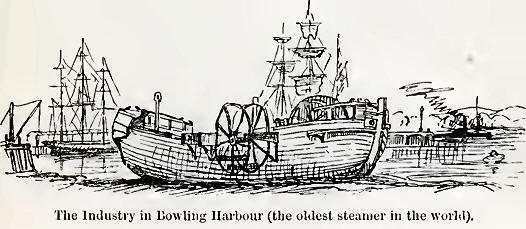
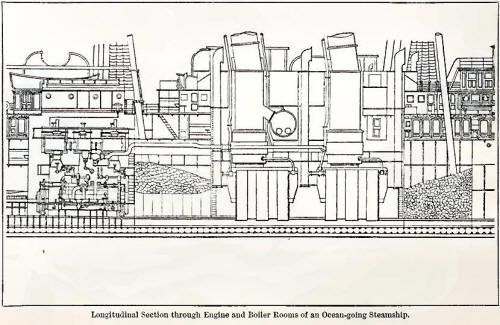
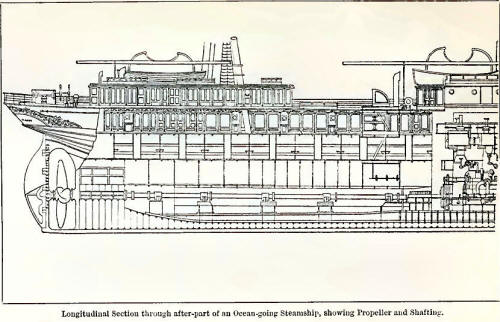 |

